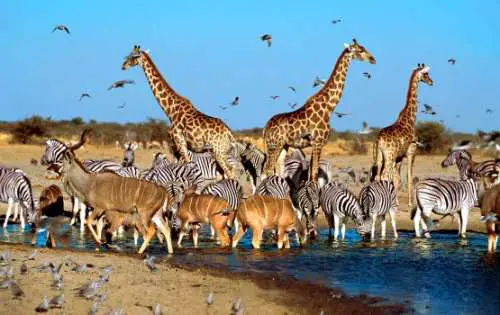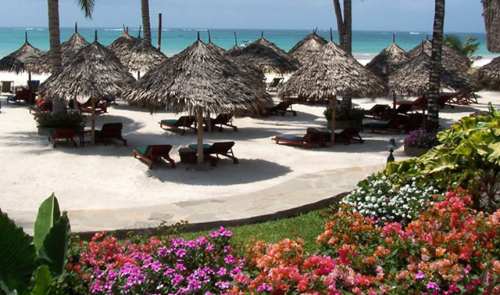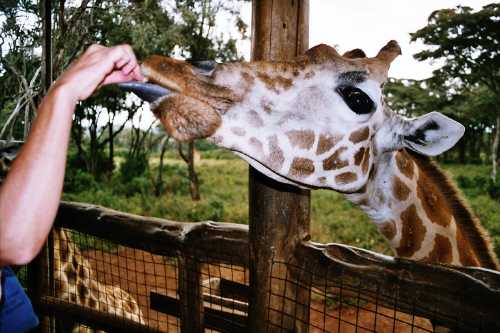Top 10 Game Reserves in Africa
Are you looking for exciting beautiful places and top-rated game reserves to visit in Africa? Don’t worry I got you. In this article, we’ll unveil the pride of wildlife conservation and natural beauty – the Top 10 Game Reserves in Africa.
Africa is a continent blessed with an abundance of natural beauty and wildlife. Its game reserves are among the most extraordinary destinations for nature enthusiasts and wildlife lovers. These protected areas provide a haven for a diverse range of animals and offer visitors a chance to witness the wonders of the animal kingdom up close.
1. Maasai Mara National Reserve, Kenya
The Maasai Mara National Reserve in Kenya is a must-visit for wildlife enthusiasts globally. Renowned for the incredible Great Migration occurring from July to October, where vast herds of wildebeest, Thomson’s gazelle, and zebra traverse between here and the Serengeti plains, this reserve offers unparalleled wildlife observation in Africa. A trip to this park stands out as a major highlight of any visit to Kenya.
Home to the renowned “Big Five” animals, the reserve boasts an abundance of predators such as lions, cheetahs, and leopards. The Mara River teems with hippos and crocodiles, contributing to its rich ecosystem.
The Maasai people, adorned in their distinctive red attire, inhabit the park and provide a captivating cultural dimension. In their native tongue, “Mara” translates to “mottled,” possibly inspired by the interplay of light filtering through the acacia trees onto the picturesque, cloud-painted horizons, creating an exquisitely captivating backdrop cherished by photographers.
Check out more tourist attractions and places to visit in Kenya.
2. Serengeti National Park, Tanzania
The Serengeti, a premier national park in Africa, is a treasure nestled in Tanzania. This renowned park, celebrated for its expansive acacia-studded plains, sun-kissed savannas, and abundant wildlife, holds the distinction of being both a World Heritage site and Tanzania’s oldest and most frequented park.
The period spanning December to July hosts the captivating Great Migration, a monumental event featuring over a million wildebeest, as well as zebras and Thomson’s gazelles, embarking on a grand journey between this park and the legendary Maasai Mara. This age-old migration stands as one of Africa’s most extraordinary natural phenomena.
Within the park’s confines reside the renowned “Big Five,” offering visitors the thrilling opportunity to witness gripping predator-prey showdowns, particularly during the arid months from June to October.
Bird enthusiasts can revel in the presence of an array of avian wonders, with more than 500 species, including the regal crowned crane and the captivating Fischer’s lovebird, gracing the skies.
3. Ngorongoro Conservation Area, Tanzania
Ngorongoro Conservation Area, once a part of Serengeti National Park, boasts remarkable features including three stunning volcanic craters, notably Ngorongoro, and the renowned archaeological site of Olduvai Gorge. Encompassing over 8,300 square kilometers of diverse landscapes like savannah, dense forests, and the African bush, this harmonious enclave is a rare coexistence of wildlife and humans, where Maasai people graze their cattle alongside a rich array of animals.
Apart from its striking volcanic scenery, the area is renowned for its abundant wildlife, including one of Africa’s highest concentrations of wild lions, black rhinoceroses, buffaloes, leopards, cheetahs, and over 500 bird species. The Great Migration, involving 1.6 million ungulates, transpires from December to June as part of the Serengeti ecosystem, presenting an awe-inspiring spectacle.
For those seeking a less crowded Tanzanian game park, the Selous Game Reserve is an optimal choice. It boasts an impressive density of game, including a thriving African wild dog population, and stands out as one of Africa’s few game reserves that permits walking safaris.
4. Amboseli National Park, Kenya
Nestled beneath Africa’s tallest peak, Mount Kilimanjaro lies a diverse park renowned for its substantial elephant herds. Ranking as Kenya’s second most popular national park after Maasai Mara National Reserve, it encompasses five distinct habitats, including swamps, woodlands, savannah, and the desiccated Lake Amboseli basin.
This ecological variety fosters a rich and abundant wildlife population, featuring iconic predators like cheetahs and lions, as well as waterbuck, gazelle, impala, and over 600 avian species.
In the dry season, photographers capture striking scenes of elephants indulging in red dust baths against the majestic backdrop of Mount Kilimanjaro. A unique opportunity also awaits visitors to engage with the Maasai tribe, residing near the park’s periphery, offering insights into their captivating way of life.
Kenya has many beautiful and exciting places to visit. To see the best places to visit in Nairobi click here, and for the best places to visit in Mombasa click here.
5. Kruger National Park, South Africa
Kruger National Park, the largest and oldest national park in South Africa, covers nearly two million hectares and is renowned for its exceptional game-viewing opportunities. It offers an unparalleled self-drive safari experience, where visitors can observe Africa’s Big Five, as well as an array of diverse wildlife such as African wild dogs, giraffes, zebras, hippos, cheetahs, and over 500 bird species.
The park’s standout feature is its ample self-catering accommodation options, rendering it a budget-friendly safari choice. Alongside the government-managed rest camps within the park, upscale luxury safari lodges and premier private game reserves can be found along its perimeters, solidifying its status as a top-tier safari destination.
Kruger National Park boasts varied landscapes ranging from dense woodlands to expansive grasslands and fertile river systems. Moreover, it holds historical significance with Bushman (San) cave paintings and archaeological sites adding to its allure.
6. Chobe National Park, Botswana
Chobe National Park in northeastern Botswana is renowned for hosting the world’s largest population of elephants and a rich array of wildlife, making it a must-see destination. It’s an excellent choice for those who enjoy self-guided safaris. The park’s northern border is graced by the scenic Chobe River, while the fertile waters of the Okavango Delta attract diverse wildlife to the south, including Africa’s “Big Five.” The Chobe River’s lush banks are frequented by large elephant herds, sable antelope, and buffaloes.
The Savuti Marsh area offers exciting predator sightings in the open savannah, while the Linyanti Marsh is a habitat for the rare red lechwe. Accommodation options range from basic campsites to luxurious game lodges, and you can even embark on a houseboat cruise along the Chobe River. Conveniently, the park’s northeast entrance is located within 100 kilometers of Zimbabwe’s breathtaking Victoria Falls, offering an enticing post-safari extension.
Botswana’s thoughtful approach to tourism involves controlling visitor numbers in the parks to safeguard these distinctive ecosystems.
7. Moremi Game Reserve, Botswana
Moremi Game Reserve, nestled within Botswana’s remarkable Okavango Delta, stands as the sole protected expanse in this captivating ecosystem. Encompassing the expansive floodplain sprawling across northwestern Botswana, it nurtures an extraordinary array of wildlife. Alongside the renowned Big Five, the reserve hosts a myriad of other creatures including hippos, giraffes, kudus, leopards, African wild dogs, and over 400 bird species.
The landscape is a tapestry of beauty, adorned with sinuous sapphire waterways, tranquil pools, grassy plains, lagoons, and dense mopane forests. Notably, Moremi holds the distinction of being Africa’s pioneer reserve initiated by local communities, driven by their concerns for diminishing wildlife.
Sharing its borders with Chobe National Park, Moremi often pairs seamlessly with it on travelers’ itineraries. Much like Chobe, Moremi lends itself to self-guided safaris, though enlisting the expertise of a local guide enhances the experience by leveraging their bush knowledge to track the game.
An exceptional activity here involves gliding along the Okavango Delta’s watercourses in a mokoro, a traditional dug-out canoe.
8. Etosha National Park, Namibia
Etosha National Park spans 22,750 square kilometers in Northern Namibia and boasts exceptional game viewing opportunities across its expansive salt pan. The arid saltpan transitions into vast grasslands and thorn scrub, providing a habitat for over 150 mammal species, including lions, zebras, elephants, cheetahs, and hyenas.
Rare and endangered creatures like the black rhino, oryx, tsessebe, and black-faced impala also find refuge here. The park hosts a variety of striking birds, with flamingos adding a burst of orange and pink during periods of abundant rain.
The optimal time for game viewing is the dry season from June to November, as animals gather at remaining waterholes. Etosha offers a well-developed tourist infrastructure for self-guided safaris, making it a favored destination. Photographers will relish the opportunity to capture wildlife against the stark, glistening landscapes that define Etosha’s unique allure.
9. South Luangwa National Park, Zambia
In eastern Zambia, South Luangwa National Park boasts a thriving wildlife population and is fed by the pristine Luangwa River, forming a sprawling 9,059 square kilometer reserve. It holds the distinction as the most favored of the three national parks within the expansive Luangwa River Valley.
Renowned for its abundance of wildlife, including leopards, lions, giraffes, buffalo, and elephants, as well as a vibrant population of hippos and crocodiles that inhabit the river’s oxbow lagoons. Remarkably, South Luangwa National Park stands as the sole location worldwide where lions are documented to prey on hippos. The park is also a haven for bird enthusiasts, housing over 400 diverse avian species.
The park’s diverse seasons create distinct landscapes. The “emerald season” (November to March), marked by rainfall, adorns the surroundings with lush greenery. Conversely, the winter months unveil a palette of golden and brown hues. Optimal game viewing occurs during the drier months (April to October) when animals gather near perennial water sources.
South Luangwa is highly regarded for its exceptional walking safaris, offering visitors a unique and immersive experience.
10. Tsavo Conservation Area, Kenya
Encompassing Tsavo West, Tsavo East, and Chyulu Hills National Park, this is Kenya’s largest park and home to a significant elephant population.
Tsavo West, renowned among these parks, features the Ngulia Rhino Sanctuary and the vibrant Mzima Springs, inhabited by crocodiles and hippos. The Chaimu Crater offers a chance to observe birds of prey. While thick vegetation in the northern part can hinder wildlife spotting, it provides a stunning backdrop for photography. Rock climbing is also a popular pursuit.
Tsavo East, situated between Nairobi and Mombasa, contrasts with its arid landscape. Dust-covered expanses witness elephant herds, baobab-adorned plains, and the meandering Galana River amid dry terrain.
Key attractions encompass the world’s lengthiest lava flow, the Yatta Plateau, along with waterfalls and a rich variety of wildlife like elephants, rhinos, lesser kudu, and lions.
Chyulu Hills National Park features verdant rolling hills, volcanic cones, craters, and caves. It’s an excellent vantage point for viewing Mount Kilimanjaro and offers exceptional bird-watching opportunities.





